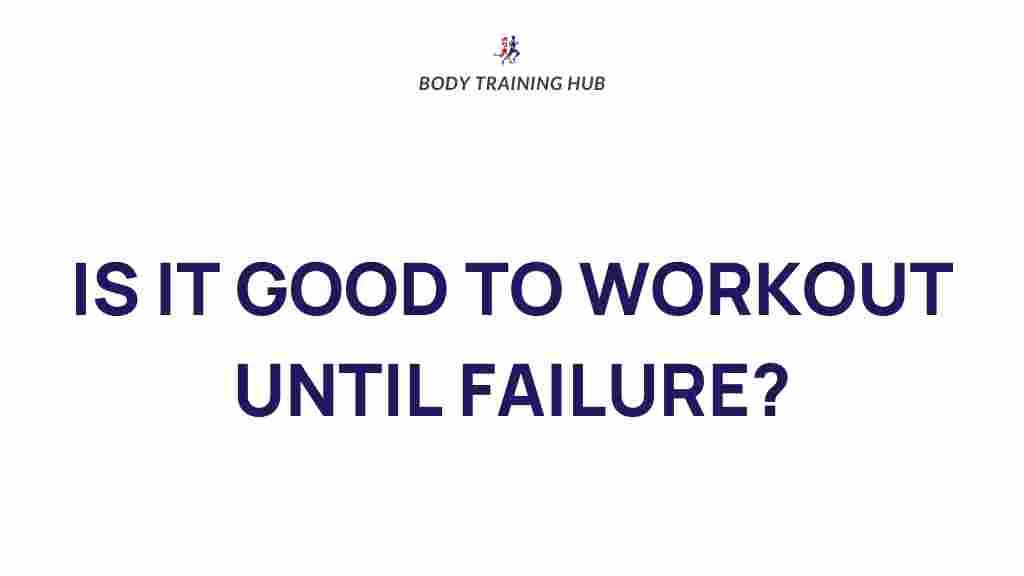Unleashing the Power of Muscle Failure: Is It Beneficial for Your Workouts?
When it comes to fitness, understanding the concept of muscle failure is essential for optimizing your workout strategies and achieving your fitness goals. Many fitness enthusiasts and trainers engage in discussions about the importance of reaching muscle failure during their resistance training sessions. But is it truly beneficial? In this article, we will explore the benefits and drawbacks of muscle failure, how it affects exercise intensity, and the overall effectiveness of your training regimen.
What is Muscle Failure?
Muscle failure occurs when your muscles can no longer perform a given number of repetitions with proper form. This is typically reached during weightlifting or resistance training when the muscle fibers have been exerted to their maximum capacity. Understanding muscle failure is key to evaluating training effectiveness and exercise intensity.
The Science Behind Muscle Failure
To grasp the benefits of muscle failure, it’s crucial to understand the physiological processes involved:
- Muscle Fiber Recruitment: As you lift weights, your body recruits muscle fibers to help perform the movement. As you approach muscle failure, more muscle fibers are engaged.
- Hypertrophy: Training to muscle failure can stimulate muscle growth by promoting muscle hypertrophy, which is the increase in muscle size due to the enlargement of its fibers.
- Hormonal Response: Intense workouts, particularly those that induce muscle failure, can elevate levels of hormones like testosterone and growth hormone, both of which play a significant role in muscle repair and growth.
Benefits of Training to Muscle Failure
Training to muscle failure can offer several advantages, particularly for those looking to enhance their training effectiveness:
- Enhanced Muscle Growth: Pushing your muscles to failure can lead to greater muscle gains due to the increased stress placed on the muscle fibers.
- Improved Strength: Regularly training to failure can help improve your overall strength, making it easier to lift heavier weights in the future.
- Increased Mental Toughness: Training to muscle failure challenges you mentally, helping to build resilience and determination in your workouts.
How to Incorporate Muscle Failure into Your Workouts
Incorporating muscle failure into your workout routines can be done strategically. Here’s a step-by-step process to safely and effectively implement this technique:
Step 1: Start with a Warm-Up
Before attempting to train to muscle failure, it’s essential to warm up properly. A good warm-up increases your heart rate, enhances blood flow to the muscles, and prepares your body for intense activity.
Step 2: Choose the Right Exercise
Select exercises that you are comfortable with and can perform with proper form. Compound movements like squats, deadlifts, and bench presses are excellent choices.
Step 3: Determine Your Rep Range
For muscle failure training, aim for a rep range of 6-12 repetitions for hypertrophy and 1-5 for strength training. Adjust the weight accordingly so that the last few reps are challenging.
Step 4: Push to Failure
As you approach the last few repetitions, focus on maintaining form. Once you can no longer perform a rep with good technique, you have reached muscle failure.
Step 5: Allow for Adequate Recovery
Training to muscle failure can be taxing on your body. Ensure you allow sufficient recovery time between workouts targeting the same muscle group to prevent overtraining.
Common Workout Strategies Involving Muscle Failure
There are various strategies you can implement when training to muscle failure:
- Drop Sets: Perform an exercise until failure, then immediately reduce the weight and continue until failure again.
- Supersets: Pair two exercises targeting opposite muscle groups and perform them back-to-back until failure.
- Rest-Pause Training: Lift to muscle failure, take a brief rest (about 10-20 seconds), then continue lifting to failure again.
Potential Risks of Training to Muscle Failure
While there are benefits to training to muscle failure, it’s important to consider the potential risks:
- Injury Risk: Lifting to failure, especially with heavy weights, can increase the risk of injury if proper form is compromised.
- Overtraining: Consistently training to failure without adequate recovery can lead to overtraining, which can hinder progress and lead to burnout.
- Mental Fatigue: Constantly pushing to failure can lead to mental fatigue, making workouts less enjoyable.
Troubleshooting Tips for Training to Muscle Failure
If you find that training to failure isn’t yielding the results you desire, consider these troubleshooting tips:
- Evaluate Your Form: Ensure your form remains impeccable as you approach muscle failure. If you’re sacrificing form, it may be time to reduce the weight.
- Adjust Your Nutrition: Make sure you’re consuming adequate protein and nutrients to support muscle recovery and growth.
- Vary Your Routine: If you’re consistently training to failure, consider varying your routine to include periods of lower intensity or different types of training.
Conclusion
In conclusion, the concept of muscle failure can be a powerful tool in your fitness arsenal, especially when aiming to enhance exercise intensity and improve training effectiveness. While there are considerable benefits to training to failure, it’s crucial to approach it with caution, paying attention to form, recovery, and overall workout strategies.
Whether you’re a seasoned athlete or a beginner, understanding how to properly implement muscle failure into your workouts can help you reach your fitness goals more effectively. Remember to listen to your body, allow for recovery, and adjust your strategies to suit your personal fitness journey.
For more tips on optimizing your training regimen, check out our article on advanced workout strategies and discover how you can further enhance your fitness experience.
Want to dive deeper into the science of muscle failure? Explore additional resources at Science of Strength Training to expand your knowledge!
This article is in the category Strength & Recovery and created by BodyTraining Team

2 thoughts on “Unleashing the Power of Muscle Failure: Is It Beneficial for Your Workouts?”